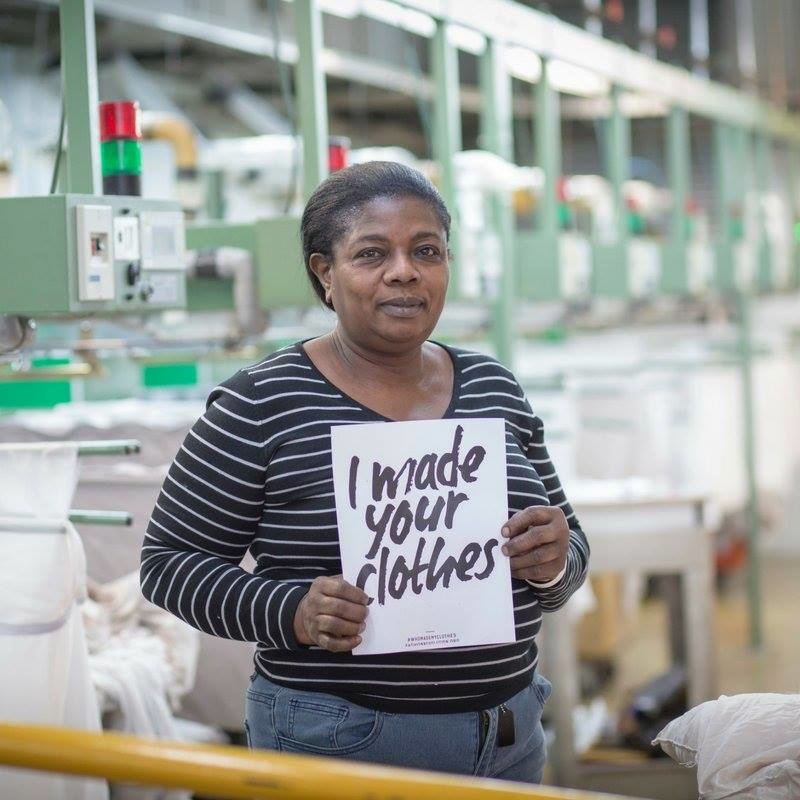

By Allison Gardner
Under what conditions were your clothes made? More likely than not, slavery has touched at least part of the outfit you’re wearing today.
According to the Global Slavery Index, roughly 40.3 million people were in slavery worldwide as of 2016, and 24.9 million of them were in forced labor. The GSI’s latest report, which came out in summer 2018, expanded upon this research, breaking down the data to show the top five products most at risk of modern slavery.
Garments were number two on the list, coming in second only to technology.

Slavery in Fashion
The fashion supply chain is complex and expansive, meaning it provides a number of opportunities for slavery to flourish. It is estimated that roughly “100 pairs of hands touch a garment during its production,” but audits are often limited to just first and second tier suppliers, meaning they typically fail to expose issues further down the supply chain. Each stage of production poses a new opportunity for worker exploitation and human rights abuses like slavery.
One example of slavery at the raw material level of the fashion supply chain can be found in the cotton industry. Often, weak protective services or poor governmental oversight leave people vulnerable to forced labor, but in some cases, the government itself is the perpetrator.
For example, Uzbekistan and Turkmenistan, the fifth and seventh largest exporters of cotton worldwide, employ state-led forced labor systems of cotton production, according to The Cotton Campaign. For decades these systems have routinely forced citizens, adults and children alike, to leave their work or school each fall in order to participate in the cotton harvest.
The Uzbek and Turkmen governments have successfully practiced this abuse of their people by threatening, detaining, assaulting, and imprisoning citizens who refuse or who attempt to report the abuse. The profits from both countries’ cotton sales remain solely with the governments.
After years of advocacy and political pressure from NGOs, this past year the government of Uzbekistan finally introduced legislation to address the state-sponsored atrocity. However, research has already shown that the 2018 harvest this past fall was still heavily reliant on forced labor.
[With the DoneGood Shop and browser plugin, you can quickly, easily, and affordably support hundreds of ethical and sustainable brands.]
Further down the supply chain, slavery also exists within the mills that spin cotton into useable material. The garment industry in India, for example, is known to have a major issue with forcing young women to work in spinning mills for little or no pay.
A system known as the “Sumangali Scheme” has been employed for years by spinning mills and garment factories in Southern India. Praying on economically disadvantaged young women in the north, factory recruiters offer them two to three year apprenticeship contracts with the promise of a lump sum of payment at the end.
For young women from poor families, this opportunity is often too good to pass up, as many of them hope to one day be married, and their families typically cannot afford a large dowry for them (sumangali in Tamil means “happily married woman”). Thus, this scheme provides factory recruiters with a mechanism to easily staff their facilities at a very low cost and appears to offer young women the opportunity to seek a better future for themselves.
In practice, however, the scheme has been shown to lead to a myriad of human rights abuses, including instances of modern day slavery. The young women are all too often subject to poor or unhygienic working and living conditions, frequently face discrimination and sexual harassment, and very often do not receive that lump sum of payment they were promised.
These are just a couple examples of slavery within the fashion industry, but there are undoubtedly many more.
A Complex Problem
Whether it’s the fields where the cotton was grown, the mills where it was spun, or the factories where the garments were sewn, the industry is notorious for providing opportunities for exploitation.
If this upsets you, and it probably should, you might wonder who’s responsibility it is to step in and fight slavery within such a complex industry.
Some might point to individual brands, arguing that they choose to work with factories and manufacturers that may or may not treat their employees well. Others may turn to the factory owner or recruiter who is directly imposing the conditions that can either support or exploit other human beings. Governments, particularly those that are uncorrupted, could also be the decision-makers.
In reality, though, there is one other group that shares the power to change this system. And that’s us, the consumers.
What We Can Do
Our consumption drives a subset of an industry that relies on exploitation. And because of that, we can also become part of the solution.
This Fashion Revolution Week, we should all ask “Who Made My Clothes?” but perhaps a follow up question is also necessary: “What Am I Doing About It?”
As consumers we have power to change the fashion industry for good, but in order to do so, we must recognize our role and acknowledge our responsibility.
The first step will undoubtedly be educating ourselves, and fortunately organizations like Fashion Revolution provide us with ample resources to do that. But the second step will likely be harder; we will need to take action.
Each person’s journey to conscious consumerism is unique, but at the very least, we can provide you with the tools to find brands who share your values. With the DoneGood Shop and browser plugin, you can quickly, easily, and affordably support hundreds of ethical and sustainable brands.


 233k
233k  41k
41k  Subscribe
Subscribe 